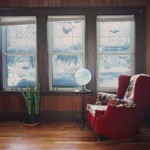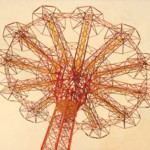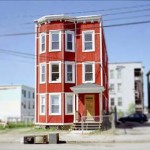By MATTHEW NASH
Currently on view at the Portland Museum of Art is the 2007 Biennial, a juried exhibition that fills the entire ground floor of the Museum, and spreads out onto the lawn and onto the eaves. Featuring 61 artists and 98 works, there is something for everyone, and both a depth and richness of experience that tie the whole group together.
Rarely can one find a theme within group shows this large and varied, but amazingly this show feels quite unified and consistent. What ties most of the work together is an emphasis on space, or site, rather than on people or personal experience. There are very few works that include people in any representative form, and even those that do are frequently studies of an environment or space rather than the experience of a person within that space.
Flipping through the exhibition catalog and reading the various artist’s statements reinforces this focus on site as a theme: “A place reveals itself slowly…” (Alan Bray); “Other times I have to return to a place over and over again…” (Tillman Crane); “The spaces are generalized, existing somewhere between intimate space and historical site…” (Eirene Efstathiou); “Like the experience of the uncanny, these spaces are at once familiar and strange.” (Sarah Malakoff)
Not every one of the 98 works in the show are about site and place, but enough of them are to create some interesting juxtapositions with the more abstract works. The circular graphite drawings of James B. Marshall, for example, may not be explicitly about site, but the dark forms (ground into the surface of the paper so deep that the paper has distorted under the pressure) are reminiscent of the rock shapes in the video work “Water & Wind: Pebble/Rain” by Ling-wen Tsai and Nathan Kolsko, or of the tiny, interlocking spirals in the nearby drawing “Knit” by Astrid Bowlby.
There is a very interesting mixture of photographs and paintings based on photographs spread throughout the galleries. Taken as a whole, nearly all of them confront the site theme directly, and most explore forms of distance or separation from their subject. Sarah Malakoff’s photographs are stunningly formal views of interior spaces, filled with muted colors and subtle textures, but absent people. Nearby, Eirene Efstathiou’s series of small paintings depict interior spaces with a calculated, painted blur that obscures details and implies memory and history. Elke Morris presents a series prints depicting rural houses. The images have been digitally altered and blurred to create a mixture of sharp and soft-focus that gives an impression of extreme depth of space but also extreme artificiality, as the changes in focus do not match those of a camera lens or of the human eye.
Several works push their distance into near-abstraction, or into a sort of amplified apathy. Yvonne Jacquette presents a painting of an aerial view at night, titled “MBNA (Credit Card Company) Parking Lot I”. The glow of the lights in the parking lot and the crooked rows of cars, evoke that uncanny feeling present in suburban office parks and shopping malls, a distinctly American experience that is most often decried in the music of youth before becoming internalized and diffuse within the ideas of adulthood. Nearby, Peter Holzhauer presents an aerial photograph of the roof of a Home Depot, the gritty grain of the black-and-white print a near match for the layered brushstrokes of Jacquette.
“Transfer Station,” a large photograph by Christopher Becker depicts a strange new world. His night image of illuminated vent pipes, protruding from a dark and unspecified field, offer these metal guardians as stand-ins for the human interaction with the space. Similarly, Mary Aro’s painting “Metal Pile”, depicting a trash-heap of metal chairs and other junk, places this human detritus in the midst of an open and green landscape. Equally as moving is Benjamin Rush’s image for a hotel ballroom in New Orleans, in which he has captured the disastrous effects Hurricane Katrina. Tania Alexia Hollander’s series of images are taken at different sites around the world but all show abstracted landscapes that fade, halfway from bottom to top, from the soft colors of earth to the faded fog-blue of sky.
Several pieces in the exhibition take the Museum itself as their site. Justin Richel’s drawings of cake and sweets create a column of color up the wall and out of sight. Within the context of the rest of the show, it is hard not to notice that they are painted on the wall, and thus site-specific works that call our attention to the artists presence within the space, and his interaction with the museum wall. Similarly, Robert Lieber's artificial "Icicles" hang outside a window, while Adriane Herman's sculptures dot the yard outside.
With the wide range of artists, styles and experiences available at the 2007 Biennial, there are many themes to be found and many great discoveries to make. There is so much work to absorb and enjoy that it is a trip worth making – especially considering that the Portland Museum has a great permanent collection and several shows parallel to the Biennial that create a comprehensive and compelling vision of art in New England for the past 200 years. Anyone with an interest in art of all varieties, from contemporary works to 19th century portraiture to 20th century modernism with find a lot to enjoy, and many new avenues for understanding how artists working today relate to, and belong within, our history of art.
This, ultimately, is the success of this Biennial. It is creating a new history from contemporary artists, many of them very young, and relating them to a worthy history. The artists of this Biennial, and the Portland Museum of Art, should all be quite proud.
- Sarah Malakoff, Untitled Interior (Blizzard), digital c-print, 2005.
- Robert Solotaire, Parachute Jump, oil on linen, 2006.
- Elke Morris, Domicile I, iris print, 2004.
"2007 Portland Museum of Art Biennial" is on view April 12 through June 10, 2007 at the Porland Museum of Art.
All images are courtesy of the artist and the Portland Museum of Art.







